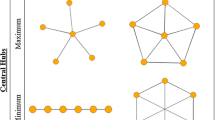Abstract
This paper uses centrality measures from complex networks to discuss how to destabilize terrorist networks. We propose newly introduced algorithms for constructing hierarchy of covert networks, so that investigators can view the structure of terrorist networks / non-hierarchical organizations, in order to destabilize the adversaries. Based upon the degree centrality, eigenvector centrality, and dependence centrality measures, a method is proposed to construct the hierarchical structure of complex networks. It is tested on the September 11, 2001 terrorist network constructed by Valdis Krebs. In addition we also propose two new centrality measures i.e., position role index (which discovers various positions in the network, for example, leaders / gatekeepers and followers) and dependence centrality (which determines who is depending on whom in a network). The dependence centrality has a number of advantages including that this measure can assist law enforcement agencies in capturing / eradicating of node (terrorist) which may disrupt the maximum of the network.
Preview
Unable to display preview. Download preview PDF.
Similar content being viewed by others
References
Albert, R., Barabási, A.L.: Dynamics of complex systems: scaling laws for the period of boolean networks, Physics Reviews 47 (2002)
Albert, R., Barabási, A.L.: Emergence of scaling in random networks. Science 286, 509–512 (1999)
Carley, K.M., Lee, J.-S., Krackhardt, D.: Destabilizing Networks. Connections 24(3), 79–92 (2002)
Carley, K.M., et al.: Destabilizing Dynamic Covert Networks. In: Proceedings of 8th International Command and Control Research and Technology Symposium, Conference held at National Defense War College, Washington, DC. Evidence Based Research Vienna, VA (2003)
Dorogovtsev, S.N., Mendes, J.F.F.: Evolution of Networks Adv. Phys. 51, 1079 (2002)
Farely, D.J.: Breaking Al Qaeda Cells: a Mathematical analysis of counterterrorism Operations Studies in conflict terrorism 26, 399–411 (2003)
Klerks, P.: The network paradigm applied to criminal organizations. Connections 24(3) (2001)
Krebs, V.: Mapping Terrorist Networks. Connections 24(3) (2002)
Latora, V., Marchiori, M.: How Science of Complex Networks can help in developing Strategy against Terrorism. Chaos, Solitons and Fractals 20, 69–75 (2004)
Nasrullah, M., Arroyo, D.O., Larsen, H.L.: Investigative Data Mining: A General Framework. In: Proceedings of International Conference on Computational Intelligence, Istanbul, Turkey, pp. 384–387 (2004)
Nasrullah, M., Larsen, H.L.: Practical Approaches for Analysis, Visualization and Destabilizing Terrorist Networks. In: Proceedings of ARES 2006: The First International Conference on Availability, Reliability and Security, Vienna University of Technology Austria (2006)
Newman, M.E.J.: The structure and function of complex networks. SIAM Review 45, 167–256 (2003)
Ravasz, E., Barabási, A.L.: Hierarchical organization in complex networks. Phys. Rev. E 67, 261121 (2003)
Strogatz, S.H.: Exploring Complex Networks. Nature 410, 268–276 (2002)
Trusina, A.S., Maslov, P.M., Sneppen, K.: Hierarchy and Anti-Hierarchy in Real and Scale Free Networks. Phys. Rev. Lett. 92, 178702 (2004)
Author information
Authors and Affiliations
Editor information
Editors and Affiliations
Rights and permissions
Copyright information
© 2006 Springer-Verlag Berlin Heidelberg
About this paper
Cite this paper
Memon, N., Larsen, H.L. (2006). Practical Algorithms for Destabilizing Terrorist Networks. In: Mehrotra, S., Zeng, D.D., Chen, H., Thuraisingham, B., Wang, FY. (eds) Intelligence and Security Informatics. ISI 2006. Lecture Notes in Computer Science, vol 3975. Springer, Berlin, Heidelberg. https://doi.org/10.1007/11760146_34
Download citation
DOI: https://doi.org/10.1007/11760146_34
Publisher Name: Springer, Berlin, Heidelberg
Print ISBN: 978-3-540-34478-0
Online ISBN: 978-3-540-34479-7
eBook Packages: Computer ScienceComputer Science (R0)




